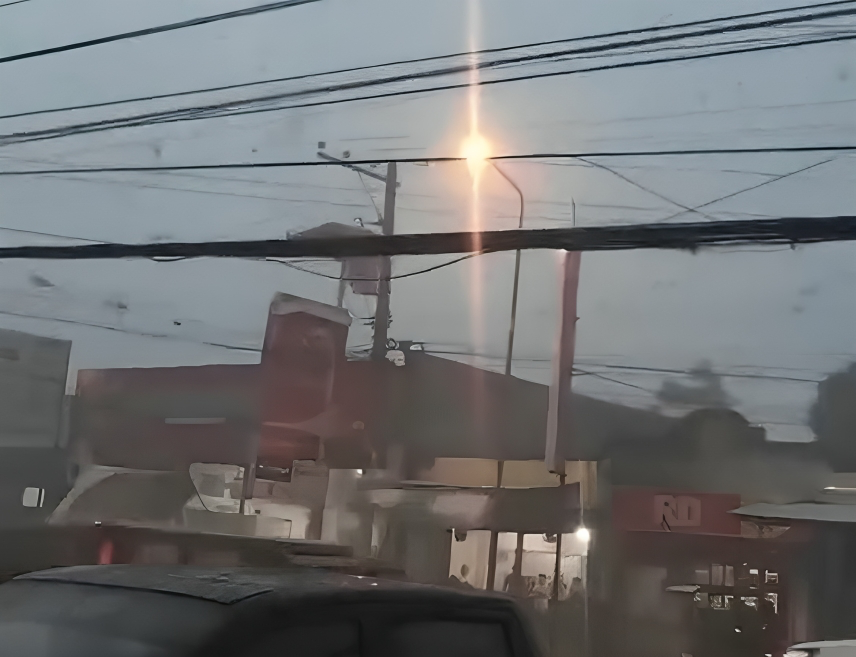
A resident in Liloan town, northern Cebu captured this video of violent blasts of strong wind on Monday, July 8. | Screenshot from video courtesy of Jan Cabello
CEBU CITY, Philippines — There is no proof that the strong gusts of wind which damaged several houses in Purok Greenhills and Purok Nangka, Barangay Poblacion, Liloan, Cebu last Monday, July 8, was a tornado.
At around 2 p.m. last Monday, an alleged tornado reportedly hit the barangay, destroying a total of 10 houses and partially damaging 71 other houses and one factory.
Due to the incident, a total of 33 families were evacuated to the Liloan Central School.
Fortunately, there were no reported injuries or casualties.
Residents in the area took videos of the strong winds as they caused destruction and assumed that a tornado had formed because of the thunderstorm.
However, a weather specialist at the Philippine Atmospheric, Geophysical, and Astronomical Services Administration (PAGASA) in Mactan said it is possible that what hit the barangay was not a tornado.
Mark Gales stated that they could not verify the existence of a tornado based on the videos taken by residents at the scene, and that the strong winds were likely “gust fronts.”
A gust front is a thunderstorm hazard which occurs when wind rapidly descends preceding the downpour of rain, he explained.
PAGASA Mactan weather specialist Joseph Merlas, for his part, stated that they saw no signatures of a tornado in the videos, particularly wind circulation.
Merlas explained that the wind movement of a tornado is always in circular motion, with a wind speed of up to 200 kilometers per hour.
A typical tornado is short-lived, lasting from seconds to three minutes, added Merlas.
Gust fronts, on the other hand, are strong winds descending in a straight line and scattering in different directions when they hit the surface.
Hence, they are also called “straight-line winds.”
Gales and Merlas both emphasized that it is possible that the strong winds which affected Barangay Poblacion were gust fronts brought by the thunderstorm, instead of a tornado.
Merlas stated that while tornadoes do not occur in the Philippines as often as in other countries, there are still chances that they can develop here.
In comparison to tornadoes in countries like the United States, tornadoes in the Philippines are not as massive and usually occur over water.
Nevertheless, these can still be destructive no matter how small or short-lived they are.
As the country enters the rainy season in the coming months, thunderstorms will likely occur more frequently.
For their safety, Gales advised the public to not be complacent and to always monitor the advisories released by PAGASA Mactan.
Here are a few reminders to stay safe in the event that a tornado forms near you:
- Promptly move away from areas where a circulated gust of wind is forming.
- Stay inside enclosed safe areas to avoid getting struck by falling debris.
- Reinforce the foundation of houses, especially those made of light materials, to ensure that they won’t be blown away.
Aside from tornadoes, lightning is also a hazard that comes during thunderstorms.
On Monday, residents observed the occurrence of lightning as the winds became stronger in Liloan.
While they do not always come together, both weather phenomena are dangerous and can cause casualties.
In Clarin town in Bohol, homeowners had to move quickly to put out the fire that engulfed their home after it was struck by lightning last July 1.
The following are the measures that individuals must take to avoid being a victim of a lightning strike:
- Find immediate shelter. Seek enclosed safe areas as soon as possible to avoid lightning strikes.
- If you are outdoors, stay away from tall and isolated objects such as trees, flagpoles, and telephone poles.
- Stay away from anything that could conduct electricity like water, water pipes, electronic gadgets, cellphones, and plug-in electrical appliances.
RELATED STORIES
Whirlwind hits Liloan, Cebu brgy, destroying houses, bunkhouse
Tornado destroys 4 houses, damages 8 in Northern Samar

